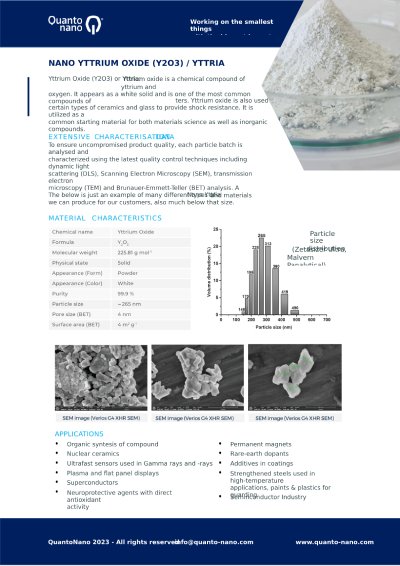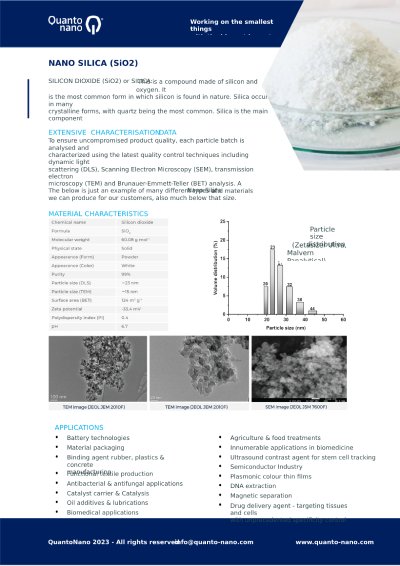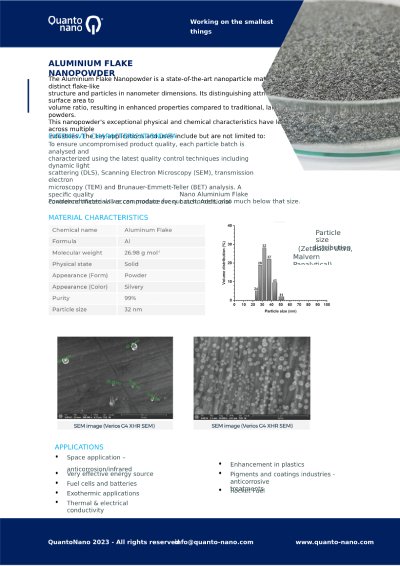Nano Materials
Biomedical Nanomaterials
Quanto Nano
Product Categories
Quanto Nano
Biomedical Nanomaterials
Liposomes are spherical vesicles with a phospholipid bilayer, used extensively in drug delivery. They encapsulate drugs, protecting them from degradation and allowing targeted delivery to specific tissues or cells, reducing side effects and improving efficacy.
Send Inquiry
Dendrimers are highly branched, tree-like structures. In medicine, they are used for drug delivery and as contrast agents in imaging. Their structure allows for precise control of size and functionality, making them suitable for targeting specific cells or tissues.
Send Inquiry
Gold nanoshells are nanoparticles with a gold shell and a dielectric core. They are used in therapeutic applications, particularly in photothermal therapy for cancer treatment, where they absorb light and convert it into heat, destroying cancer cells.
Send Inquiry
These nanoparticles are controlled via external magnetic fields, making them ideal for targeted drug delivery. They are used in cancer therapy to direct chemotherapeutic agents directly to tumor sites, minimizing damage to healthy tissues.
Send Inquiry
Carbon Nanotubes are used for drug delivery, biosensing, and tissue engineering. Their high surface area and unique physical properties make them suitable for delivering drugs and genes into cells and for creating scaffolds in tissue engineering.
Send Inquiry
Nanocrystals used in imaging and diagnostics, Quantum Dots are known for their bright and stable luminescence, which can be tuned by changing their size. They are used for cellular imaging and as fluorescent tags in biomedical research.
Send Inquiry
Employed in drug delivery and diagnostics, their porous structure allows them to carry a wide range of therapeutic agents. They can be engineered to release drugs at specific sites or in response to certain conditions, improving treatment effectiveness.
Send Inquiry
Used in controlled drug release systems, these nanoparticles can be designed to release their payload in response to specific physiological conditions. They offer a platform for delivering a range of drugs, including small molecules, proteins, and nucleic acids.
Send Inquiry
Utilized for drug delivery and imaging, Nanodiamonds are known for their biocompatibility and ability to carry a range of molecules. They are promising for biomedical applications, including drug delivery and as markers in imaging.
Send Inquiry
Used in drug and gene delivery, Fullerenes have a unique carbon-cage structure that can encapsulate various therapeutic agents. They are explored for their antioxidant properties and ability to deliver drugs and genes to targeted cells.
Send Inquiry
Employed in drug delivery and sensing, MOFs have a highly ordered and porous structure that allows for high drug loading capacity and controlled release. They are being developed for use in delivering a variety of therapeutic agents and in diagnostic applications.
Send Inquiry
Used in vaccine delivery and cancer therapy, these nanoparticles can mimic proteins and peptides in the body, making them effective for targeted treatments. They are designed to elicit strong immune responses or to deliver drugs to specific types of cells.
Send Inquiry
Summary
Nanomaterials in biomedical applications offer transformative solutions in drug delivery, diagnostics, and therapy. From liposomes for targeted drug delivery to quantum dots for precise imaging, these nanoscale structures are revolutionizing how diseases are diagnosed and treated. Their unique properties, such as enhanced targeting, controlled release, and biocompatibility, make them vital tools in advancing medical science and patient care.

WE WORK ON THE SMALLEST THINGS WITH THE BIGGEST IMPACT











